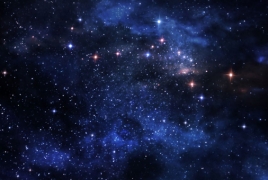Green-hot galaxies give clues to the ancient universe January 16, 2017 - 18:18 AMT PanARMENIAN.Net - Galaxies that emit a green glow make bitchin' screen-savers, but they're exceedingly rare in the actual universe. However, UCLA astronomers recently discovered that most, if not all early galaxies had a green hue due to their intense heat and special chemistry, Engadget reports. "The discovery that young galaxies are so unexpectedly bright [with green light] ... will dramatically change and improve the way that we study galaxy formation throughout the history of the universe," said UCLA physics Professor Matthew Malkan in a statement. Galaxies normally glow white, with slight variations in color. Galaxies with a lot of hydrogen gas, signalling young galaxies and star formation, can look slightly pink, for instance. Others with lots of cool red stars can have red, orange or yellow tints. Green galaxies are much rarer, because they require very specific conditions. For one, you need a galaxy with supernovae to spawn oxygen formation. Then, you need stars that burn at around 50,000 degrees Kelvin, approaching temperatures of the hottest known stars in the universe. The hot stars can then ionize the oxygen clouds not just once, but twice, creating a green-glowing O++ "doubly-ionized" cloud in the green light spectrum. Usually, those stars only exist in very small "dwarf galaxies," with one of the most common types being "green pea galaxies." J0925+1403 (above), spotted by the Hubble Telescope, is a green pea just a 20th the size of the Milky Way, for example. Scientists detected that it was ejecting ionized photons at never-before-seen intensities, approaching those of X-rays. Malkan believes that's because young stars were hotter in galaxies that formed in the early universe. Malkan and his team pored through the Subaru Deep Field, created by the 8.2 meter (27-foot) Subaru Telescope in Hawaii, and found that all the small galaxies were "surprisingly strong emitters" of green light. Furthermore, the early universe (under 2 billion years old and 70 times more dense than today) is made up mostly from such dwarf galaxies. Luckily, future spacecraft like the James Webb Space Telescope (launching in 2018), and the WFIRST are equipped with O++ spectrum detectors. The aim is to spot very young galaxies forming their first stars and supernovae, and according to Malkan's research, they'll have plenty of targets to check. "Detecting and studying the intense green glow from the youngest galaxies now looks like our best opportunity for learning how the first galaxies evolved," he said. Yerevan will host the 2024 edition of the World Congress On Information Technology (WCIT). Rustam Badasyan said due to the lack of such regulation, the state budget is deprived of VAT revenues. Krisp’s smart noise suppression tech silences ambient sounds and isolates your voice for calls. Gurgen Khachatryan claimed that the "illegalities have been taking place in 2020." Partner news |